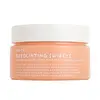What's inside
What's inside
 Key Ingredients
Key Ingredients

 Benefits
Benefits

 Concerns
Concerns

 Ingredients Side-by-side
Ingredients Side-by-side

Water
Skin ConditioningAlcohol
AntimicrobialHamamelis Virginiana Water
AstringentGlycerin
HumectantLactic Acid
BufferingSalix Alba Bark Extract
AstringentLactobacillus Ferment
Skin ConditioningCarica Papaya Fruit Extract
Skin ConditioningOxycoccus Palustris Seed Oil
AntioxidantRubus Chamaemorus Seed Oil
Skin ConditioningBuddleja Davidii Extract
Skin ConditioningThymus Vulgaris Flower/Leaf Extract
MaskingCamellia Sinensis Leaf Extract
AntimicrobialAngelica Archangelica Root Water
Skin ConditioningLeuconostoc/Radish Root Ferment Filtrate
AntimicrobialSimmondsia Chinensis Seed Oil
EmollientSodium Hydroxide
BufferingSucrose Palmitate
EmollientGlycosphingolipids
EmollientPerfluorodecalin
Skin ConditioningBiosaccharide Gum-1
HumectantPotassium Sorbate
PreservativeSodium Benzoate
MaskingXanthan Gum
EmulsifyingLimonene
PerfumingT-Butyl Alcohol
PerfumingParfum
MaskingWater, Alcohol, Hamamelis Virginiana Water, Glycerin, Lactic Acid, Salix Alba Bark Extract, Lactobacillus Ferment, Carica Papaya Fruit Extract, Oxycoccus Palustris Seed Oil, Rubus Chamaemorus Seed Oil, Buddleja Davidii Extract, Thymus Vulgaris Flower/Leaf Extract, Camellia Sinensis Leaf Extract, Angelica Archangelica Root Water, Leuconostoc/Radish Root Ferment Filtrate, Simmondsia Chinensis Seed Oil, Sodium Hydroxide, Sucrose Palmitate, Glycosphingolipids, Perfluorodecalin, Biosaccharide Gum-1, Potassium Sorbate, Sodium Benzoate, Xanthan Gum, Limonene, T-Butyl Alcohol, Parfum
Ingredients Explained
These ingredients are found in both products.
Ingredients higher up in an ingredient list are typically present in a larger amount.
Lactic Acid is another well-loved alpha hydroxy acid (AHA). It is gentler than glycolic acid but still highly effective.
Its main role is to exfoliate the surface of the skin by loosening the “glue” that holds dead skin cells together. Shedding those old cells leads to smoother, softer, and more even-toned skin.
Because lactic acid molecules are larger than glycolic acid, they don’t penetrate as deeply. This means they’re less likely to sting or irritate, making it a great choice for beginners or those with sensitive skin.
Like glycolic acid, it can:
Lactic acid also acts as a humectant (like hyaluronic acid). It can draw water into the skin to improve hydration and also plays a role in the skin's natural moisturizing factor (NMF) in the form of sodium lactate.
Studies show it can boost ceramide production to strengthen the skin barrier and even help balance the skin’s microbiome.
To get results, choose products with a pH between 3-4.
Lower strengths (5-12%) focus on surface exfoliation; higher strengths (12% and up) can reach deeper in the dermis (deeper, supportive layer) to improve skin texture and firmness over time.
Though it was originally derived from milk, most modern lactic acid used in skincare is vegan. It is made through non-dairy fermentation to create a bio-identical and stable form suitable for all formulations.
When lactic acid shows up near the end of an ingredient list, it usually means the brand added just a tiny amount to adjust the product’s pH.
Legend has it that Cleopatra used to bathe in sour milk to help reduce wrinkles.
Lactic acid is truly a gentle multitasker: it exfoliates, hydrates, strengthens, and brightens. It's a great ingredient for giving your skin a smooth, glowing, and healthy look without the harshness of stronger acids.
Read more about some other popular AHA's here:
Learn more about Lactic AcidParfum is a catch-all term for an ingredient or more that is used to give a scent to products.
Also called "fragrance", this ingredient can be a blend of hundreds of chemicals or plant oils. This means every product with "fragrance" or "parfum" in the ingredients list is a different mixture.
For instance, Habanolide is a proprietary trade name for a specific aroma chemical. When used as a fragrance ingredient in cosmetics, most aroma chemicals fall under the broad labeling category of “FRAGRANCE” or “PARFUM” according to EU and US regulations.
The term 'parfum' or 'fragrance' is not regulated in many countries. In many cases, it is up to the brand to define this term.
For instance, many brands choose to label themselves as "fragrance-free" because they are not using synthetic fragrances. However, their products may still contain ingredients such as essential oils that are considered a fragrance by INCI standards.
One example is Calendula flower extract. Calendula is an essential oil that still imparts a scent or 'fragrance'.
Depending on the blend, the ingredients in the mixture can cause allergies and sensitivities on the skin. Some ingredients that are known EU allergens include linalool and citronellol.
Parfum can also be used to mask or cover an unpleasant scent.
The bottom line is: not all fragrances/parfum/ingredients are created equally. If you are worried about fragrances, we recommend taking a closer look at an ingredient. And of course, we always recommend speaking with a professional.
Learn more about ParfumPotassium Sorbate is a preservative used to prevent yeast and mold in products. It is commonly found in both cosmetic and food products.
This ingredient comes from potassium salt derived from sorbic acid. Sorbic acid is a natural antibiotic and effective against fungus.
Both potassium sorbate and sorbic acid can be found in baked goods, cheeses, dried meats, dried fruit, ice cream, pickles, wine, yogurt, and more.
You'll often find this ingredient used with other preservatives.
Learn more about Potassium SorbateWater. It's the most common cosmetic ingredient of all. You'll usually see it at the top of ingredient lists, meaning that it makes up the largest part of the product.
So why is it so popular? Water most often acts as a solvent - this means that it helps dissolve other ingredients into the formulation.
You'll also recognize water as that liquid we all need to stay alive. If you see this, drink a glass of water. Stay hydrated!
Learn more about Water